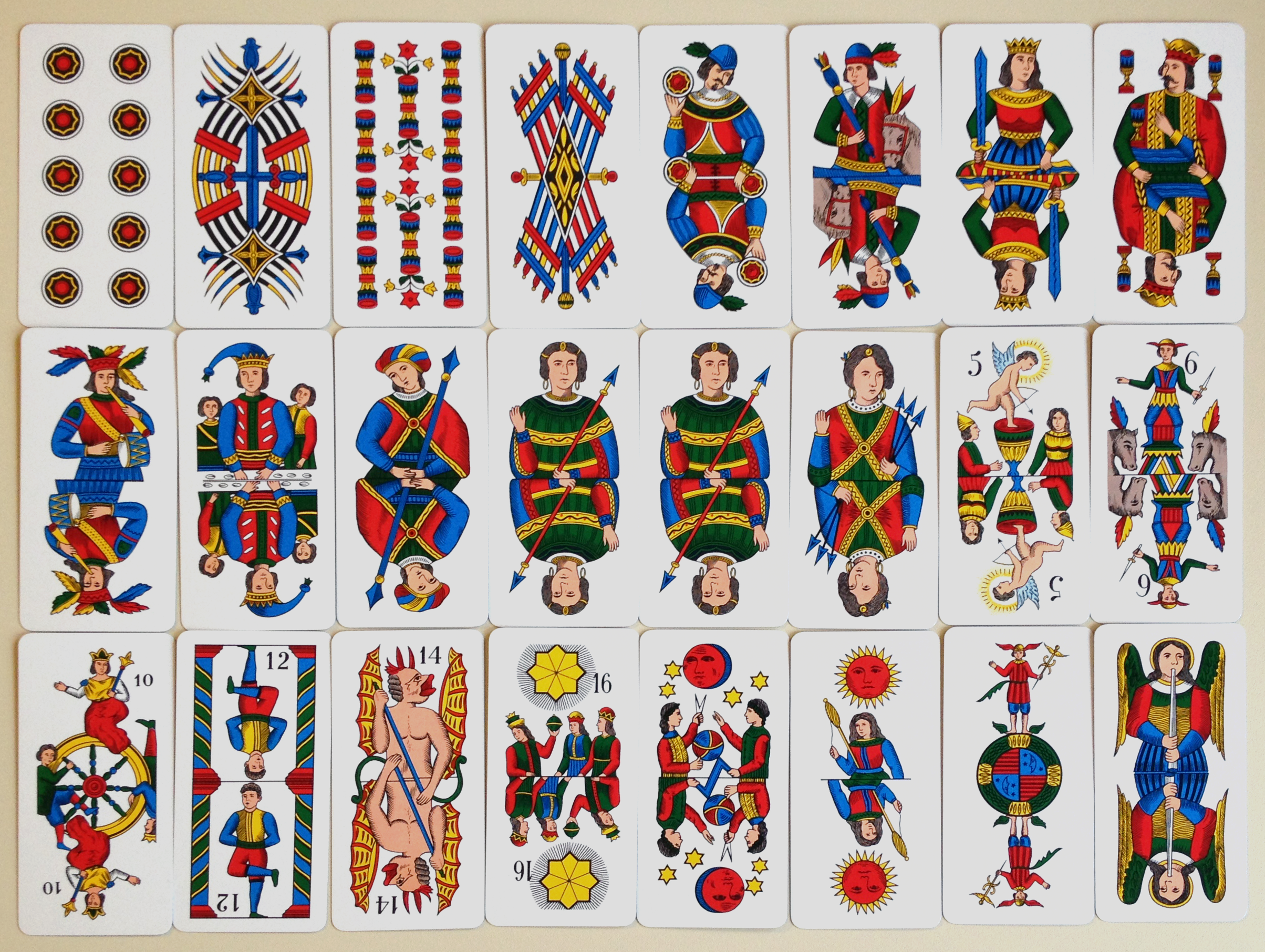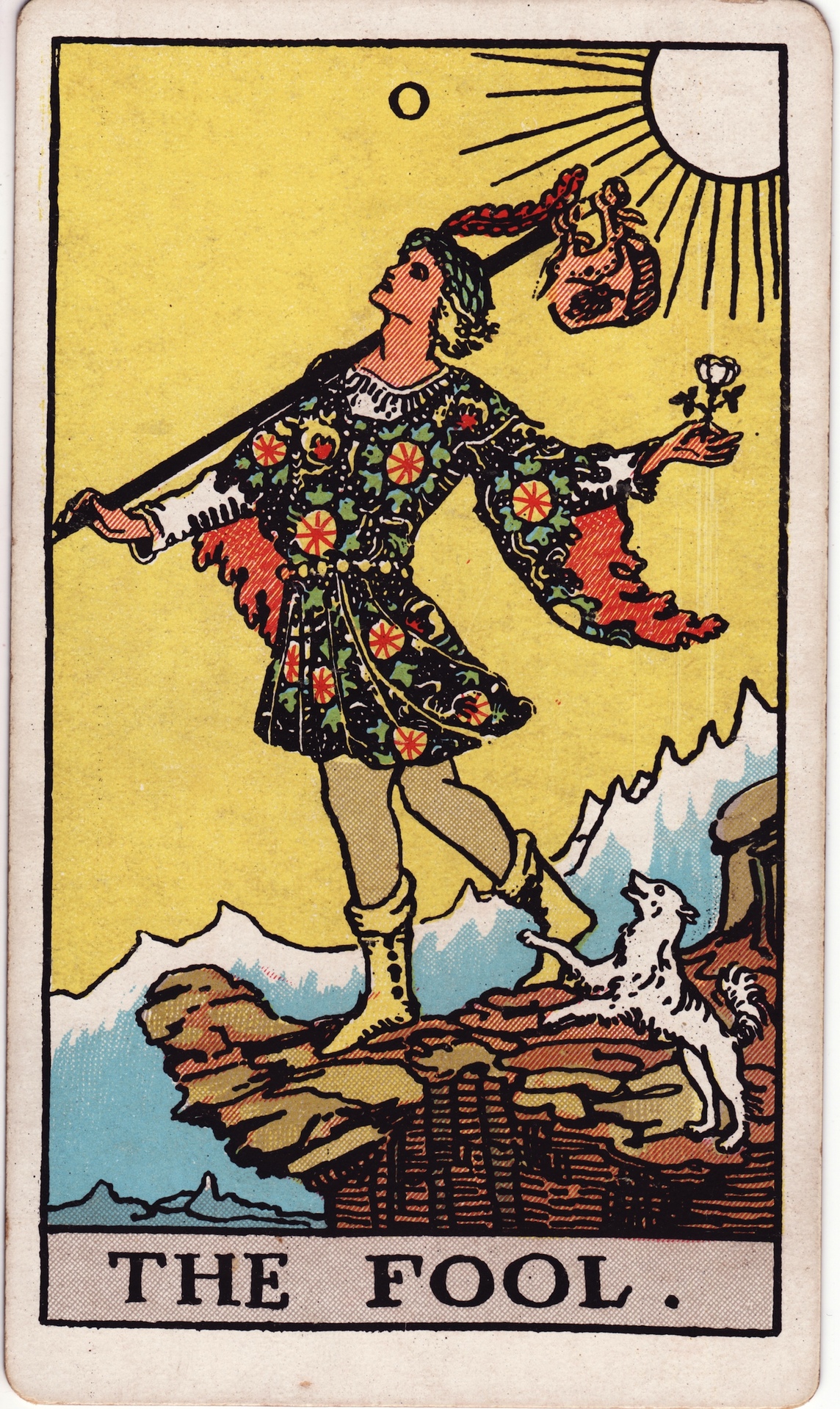|
Troccas
Troccas is a member of the Tarot family of card games. It is a four player game played in the Romansh speaking part of the canton Grisons of Switzerland. It is not known exactly how this game entered Switzerland but it is generally thought to have arrived from Italy during the 17th century. Troccas decks are sometimes called " 1JJ" or "Jupiter and Juno" decks because they substitute ''Jupiter'' and ''Juno'' for the Pope and Papess of the Tarot of Marseilles. The deck's captions are usually in French or German, but a version with English captions has been published. The cards The 78-card Swiss 1JJ Tarot is traditionally used but it can be substituted by a Tarot Nouveau deck. Swiss 1JJ uses Italian suits (swords, sticks, cups, and coins) while Tarot Nouveau uses French suits. Cards use traditional ranking, where red (or round) suits rank in reverse: K, Q, C, V, 1, 2, 3, 4, 5, 6, 7, 8, 9, 10. 1JJ cards are referred to in the game by their Romansh (Rhæto-Romanic) names, b ... [...More Info...] [...Related Items...] OR: [Wikipedia] [Google] [Baidu] |
Swiss 1JJ Tarot
The Swiss 1JJ Tarot deck is a 78-card deck used for the tarot card games Troccas and Troggu and also for divination. History The deck is derived from the Tarot de Besançon, which itself comes from the Tarot of Marseilles. It is an Italian suited pack which substitutes the figures of Juno and Jupiter in place of the Popess and Pope of the Tarot of Marseilles. The first version was produced between 1831 and 1838 in the card factory of Johann Georg Rauch. It was the first tarot pack made by the factory and was unexpectedly successful in the American market. The first version was manufactured, unaltered, by his successor, Johannes Müller in Diessenhofen until 1860.Ruh, Max (2005) ''Schaffhauser Spielkarten. Schweizer Pioniere der Wirtschaft und Technik.'' Verein für wirtschaftshistorische Studien, Zurich 2005, , pp 27–31, 52 and 73. In 1965 the Swiss card game firm, AGMüller, issued a reprint which is distinguished by its cleaner lines. The pack owes its name to this editio ... [...More Info...] [...Related Items...] OR: [Wikipedia] [Google] [Baidu] |
Troggu
Troggu is a member of the tarot family of card games. Synonyms for the game's name are: Trogga, Tappu and Tappä. It is played in the area of Visp, Switzerland, in Upper Wallis, especially in St. Niklaus and Grächen. After Troccas, it is the second most played tarot card game in Switzerland. History According to card game researcher, John McLeod, Troggu was probably invented in the 18th century. The reasons for this assumption concerns the rules for the Fool. In earlier Tarot card games and in modern French tarot, the fool is played as an "Excuse", a card which exempts the player from following suit. In modern Tarock games in such regions as Austria and Hungary, the fool is played as Tarock XXII, the highest ranking trump. The rules of Troggu contain a mixture of both variations and may be a transitional game from the traditional rules of the Fool to the more modern one.McLeod, JohnTrogguat pagat.com. Retrieved 8 December 2017. Troggu or a related game may have spread to Be ... [...More Info...] [...Related Items...] OR: [Wikipedia] [Google] [Baidu] |
Tarot Of Marseilles
The Tarot of Marseilles is a standard pattern of Italian-suited tarot pack with 78 cards that was very popular in France in the 17th and 18th centuries for playing tarot card games and is still produced today. It was probably created in Milan before spreading to much of France, Switzerland and Northern Italy. The name is sometimes spelt Tarot of Marseille, but the name recommended by the International Playing-Card Society is Tarot de Marseille, although it accepts the two English names as alternatives. "Page of Batons"), the title of that card generally appears on the side of the card, while in some old versions of the Tarot de Marseille that card, along with either some or all others, is left unnamed. In the Tarot de Marseille, as is standard among Italian suited playing cards, the pip cards in the suit of swords are drawn as abstract symbols in curved lines, forming a shape reminiscent of a mandorla. On the even numbered cards, the abstract curved lines are all that is present ... [...More Info...] [...Related Items...] OR: [Wikipedia] [Google] [Baidu] |
Tarot Card Games
Tarot games are card games played with tarot decks, that is, decks with numbered permanent trumps parallel to the suit cards. The games and decks which English-speakers call by the French name Tarot are called Tarocchi in the original Italian, Tarock in German and various similar words in other languages. The basic rules first appeared in the manuscript of Martiano da Tortona, written before 1425. The games are known in many variations, mostly cultural and regional. Tarot games originated in Italy, and spread to most parts of Europe, notable exceptions being the British Isles, the Iberian peninsula, and the Balkans.David Parlett, ''Oxford Dictionary of Card Games'', pg. 300 Oxford University Press (1996) They are played with decks having four ordinary suits, and one additional, longer suit of tarots, which are always trumps. They are characterised by the rule that a player who cannot follow to a trick with a card of the suit led ''must'' play a trump to the trick if possible. T ... [...More Info...] [...Related Items...] OR: [Wikipedia] [Google] [Baidu] |
Italian Playing Cards
Playing cards (''carte da gioco'') have been in Italy since the late 14th century. Until the mid 19th century, Italy was composed of many smaller independent states which led to the development of various regional patterns of playing cards; "Italian suited cards" normally only refer to cards originating from northeastern Italy around the former Republic of Venice, which are largely confined to northern Italy, parts of Switzerland, Dalmatia and southern Montenegro. Other parts of Italy traditionally use traditional local variants of Spanish suits, French suits or German suits. As Latin-suited cards, Italian and Spanish suited cards use swords (''spade''), cups (''coppe''), coins (''denari''), and clubs (''bastoni''). All Italian suited decks have three face cards per suit: the ''fante'' ( Knave), ''cavallo'' (Knight), and ''re'' (King), unless it is a tarocchi deck in which case a ''donna'' or ''regina'' (Queen) is inserted between the ''cavallo'' and ''re''. Popular games ... [...More Info...] [...Related Items...] OR: [Wikipedia] [Google] [Baidu] |
Card Games Involving Signalling
Card or The Card may refer to: * Various types of plastic cards: **By type ***Magnetic stripe card ***Chip card *** Digital card **By function ***Payment card ****Credit card ****Debit card ****EC-card ****Identity card ****European Health Insurance Card ****Driver's license * Playing card, a card used in games * Printed circuit board * Punched card, a piece of stiff paper that holds digital data represented by the presence or absence of holes in predefined positions. *In communications ** Postcard ** Greeting card, an illustrated piece of card stock featuring an expression of friendship or other sentiment * \operatorname, in mathematical notation, a function that returns the cardinality of a set * Card, a tool for carding, the cleaning and aligning of fibers * Sports terms ** Card (sports), the lineup of the matches in an event ** Penalty card As a proper name People with the name * Card (surname) Companies * Cards Corp, a South Korean internet company Arts and entertainment * ... [...More Info...] [...Related Items...] OR: [Wikipedia] [Google] [Baidu] |
Tujetsch
Tujetsch (; german: Tavetsch) is a municipality in the Surselva Region in the canton of Graubünden in Switzerland. It is the westernmost municipality of the canton, connected to Urseren ( canton of Uri) by the Oberalp Pass. History The upper Surselva was first settled in the 9th century, following the foundation of Disentis Abbey, as part of the '' Cadi'' (feudal possessions of the abbey). In the 12th century, the Walser migrated across Oberalp Pass. Sedrun parish church was first consecrated in 1205. Both Romansh and Walser communities lived exclusively in dispersed settlements well into the early modern period. The Walser were mostly Romanized, but some Alemannic toponymy remains on the left bank of the Rhine. In the 18th century, villages formed in the vicinity of parish churches, and most of the 66 scattered settlements recorded in the 16th century were abandoned. Sedrun became the main settlement and municipal capital. The economic focus shifted from alpine agriculture t ... [...More Info...] [...Related Items...] OR: [Wikipedia] [Google] [Baidu] |
Medel (Lucmagn)
Medel () is a municipality in the Surselva Region in the Swiss canton of Graubünden. History Medel (Lucmagn) is first mentioned in 1315 as ''de valle Mederis''. Geography Medel (Lucmagn) has an area, , of . Of this area, 17.8% is used for agricultural purposes, while 14.9% is forested. Of the rest of the land, 0.6% is settled (buildings or roads) and the remainder (66.8%) is non-productive (rivers, glaciers or mountains). Before 2017, the municipality was located in the Disentis sub-district of the Surselva district, after 2017 it was part of the Surselva Region. accessed 16 February 2017 It is located in the Medelserrh ... [...More Info...] [...Related Items...] OR: [Wikipedia] [Google] [Baidu] |
The Fool (Tarot Card)
The Fool is one of the 78 cards in a tarot deck. In tarot card reading, it is one of the 22 Major Arcana, sometimes numbered as 0 (the first) or XXII (the last). However, in decks designed for playing traditional tarot card games, it is typically unnumbered, as it is not one of the 21 trump cards and instead serves a unique purpose by itself. Iconography The Fool is titled ''Le Mat'' in the Tarot of Marseilles, and ''Il Matto'' in most Italian language tarot decks. These archaic words mean "the madman" or "the beggar", and may be related to the word for 'checkmate' in relation to the original use of tarot cards for gaming purposes. In the earliest tarot decks, the Fool is usually depicted as a beggar or a vagabond. In the Visconti-Sforza tarot deck, the Fool wears ragged clothes and stockings without shoes, and carries a stick on his back. He has what appear to be feathers in his hair. His unruly beard and feathers may relate to the tradition of the woodwose or wild man. Anot ... [...More Info...] [...Related Items...] OR: [Wikipedia] [Google] [Baidu] |
Tarot Nouveau
The Bourgeois Tarot deck is a mid-19th century pattern of tarot cards of German origin that is still used for playing card games today in western Europe and Canada. It is not designed for divinatory purposes.''Bourgeois Tarot by Piatnik 1987'' at wopc.co.uk. Retrieved 11 Septemberg 2022. This deck is most commonly found in , Belgian , Swiss and Canadian |
French Playing Cards
French-suited playing cards or French-suited cards are playing cards, cards that use the French Suit (cards), suits of (clovers or clubs ), (tiles or diamonds ), (hearts ), and (pikes or spades ). Each suit contains three or four face cards, face/court cards. In a standard 52-card pack these are the (jack (playing card), knave or jack), the (queen (playing card), lady or queen), and the (king (playing card), king). In addition, in Tarot packs, there is a (Cavalier (playing card), cavalier) ranking between the queen and the knave. Aside from these aspects, decks can include a wide variety of regional and national patterns, which often have stripped deck, different deck sizes. In comparison to Spanish playing cards, Spanish, Italian playing cards, Italian, German playing cards, German, and Swiss playing cards, French cards are the most widespread due to the geopolitical, commercial, and cultural influence of France, the United Kingdom, and the United States ... [...More Info...] [...Related Items...] OR: [Wikipedia] [Google] [Baidu] |









.jpg)